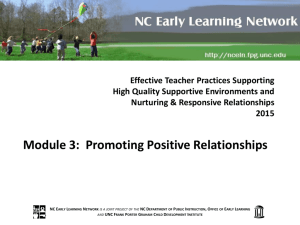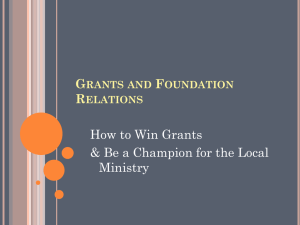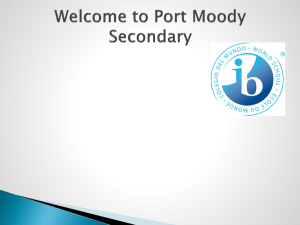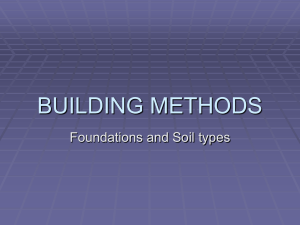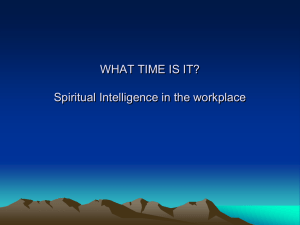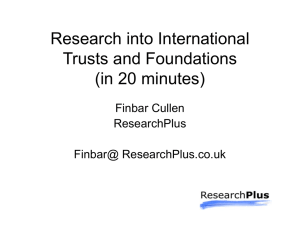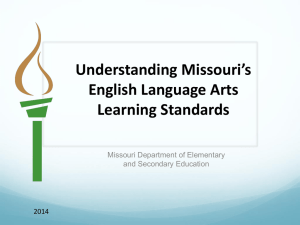Foundations for Early Learning and Development
advertisement
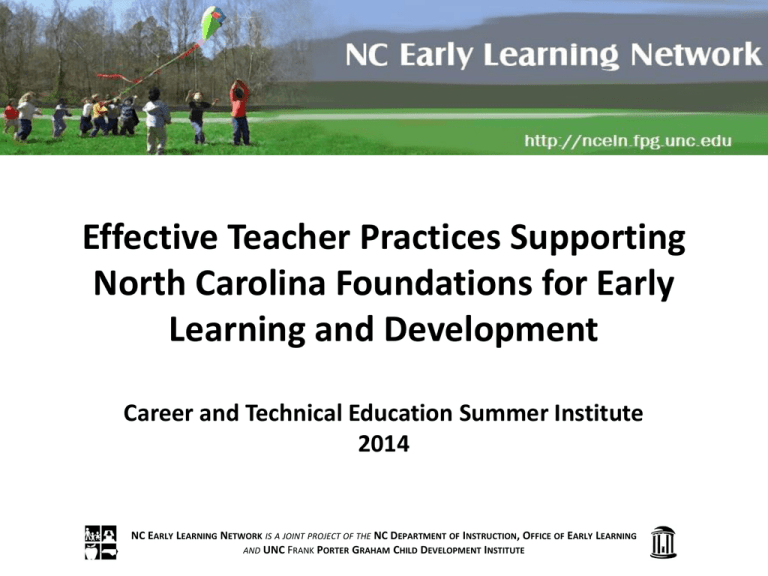
Effective Teacher Practices Supporting North Carolina Foundations for Early Learning and Development Career and Technical Education Summer Institute 2014 NC EARLY LEARNING NETWORK IS A JOINT PROJECT OF THE NC DEPARTMENT OF INSTRUCTION, OFFICE OF EARLY LEARNING AND UNC FRANK PORTER GRAHAM CHILD DEVELOPMENT INSTITUTE Welcome and introductions Who is with us today? 2 Objectives Become familiar with • Revised Foundations for Early Learning and Development • NC Department of Public Instruction’s plan for rollout of revised Foundations • Seven professional development modules on ‘Effective Teacher Practices Supporting North Carolina Foundations for Early Learning and Development’ 3 The Back Story How we got where we are today 4 Foundations’ Five Developmental Domains Approaches to Learning EmotionalSocial Development Health & Physical Development Cognitive Development Language Development & Communication 5 Foundations Treasure Hunt! 6 On what page(s) will you find… 1. The age periods used for developmental indicators (infants, younger toddlers, older toddlers, younger preschoolers, and older preschoolers) (Hint – look in pages 1-7!) 2. A text box that summarizes the intended uses for Foundations (Hint – look in pages 1-7!) 3. A summary of the document’s organization and guidance on how to think about developmental domains and their overlap (Hint – look in pages 1-7!) 4. A list of how goals and developmental indicators should and should not be used? (Hint – look in pages 1-7!) 5. The subdomains and goals for each of the five domains listed? (Hint – look beyond pages 1-7!) 7 Developmental Indicator Continuum Developmental Goals Infants: birth to 12 months Younger Toddlers: 8 – 21 months Older Toddlers: 1836 months Younger Preschoolers: 36-48 months Older Preschoolers: 48-60+ months Continuum of Growth 8 Standards, Curriculum, and Formative Assessment Standards • Define the expectations for knowledge and skills children should have • Organized by age level Curriculum • Based on developmental literature • Assumes additive acquisition of knowledge Formative Assessment Adapted from Corcoran, Mosher & Rogat, 2011 9 Standards, Curriculum, and Formative Assessment Standards • Scope: the breadth and depth of content to be covered Curriculum • Sequence: the order in which content is presented Formative Assessment • Provides activities to facilitate critical areas of development and learning that can be embedded in classroom routines 10 Standards, Curriculum, and Formative Assessment Standards Curriculum • A process used by teachers and children during play and learning activities, • that provides feedback to the teachers and children, • so that teachers can adjust their teaching to meet the needs of children, and Formative Assessment • so that children can understand what is expected of them. Adapted from The Council of Chief State School Officers, October 2006 11 Relationship between Foundations and NC Standard Course of Study English Language Arts 3rd Grade: Recounts stories 5th Grade: Identify main points of stories High School: Analyze how author selected words and organized text for meaning Older Preschooler: Story sequence 12 Relationship between Foundations and NC Standard Course of Study Mathematics 3rd Grade: Older Preschooler: Patterning 5th Grade: Analyze patterns and relationships High School: Arithmetic with polynomials and rational expressions Identify and explain patterns in arithmetic 13 Relationship between Foundations and NC Standard Course of Study Science 3rd Grade: Understand human body systems Older Preschooler: Awareness of body 5th Grade: Understand how organisms perform functions necessary for life High School: Understand cells and organisms: evolution and genetics 14 Relationship between Foundations and NC Standard Course of Study Social Studies Older Preschooler: Recognize the roles of people in the community 3rd Grade: Understand how events and individuals have influenced communities 5th Grade: Chronicle key events and people in US history High School: Understands creation and development of societies and civilizations 15 Alignment Implementation Science Kindergarten Entry Child Profile Formative Assessment 16 Stakeholder Input Identifying professional development needs for schools systems and the early intervention program – Stakeholder input helped to identify priorities for training and resources needed to implement into teacher/practitioner practices 17 Training Content Priorities • Embed the Foundations and NC Professional Teaching Standards into existing professional development initiatives • Focus on “instructional practices” • Cross-walk to Common Core to communicate alignment with K-12 18 What does high quality early childhood instruction look like? What are research-based When a teacher practices for early implements a research childhood? based practice, what NC Professional Teaching Standard is she addressing? 19 Teaching Standards http://www.ncpublicschools.org/docs/effectiveness-model/ncees/standards/prof-teach-standards.pdf 20 What early learning standard is the teacher addressing in her practice? When a teacher implements a research based practice What early learning and development standard is she/he addressing? 21 What Teacher Standard Do You See? 22 Crosswalk to NC Standard Course of Study What is the relationship? 23 Alignment Kindergarten Standard Course of Study NC Foundations for Early Learning and Development 24 Foundations Training Modules The “Why” Behind the Structure of the Modules 25 Seven Training Modules • • • • 90 Minute Modules PowerPoints Handouts Recommended delivery in professional learning community sessions over the course of 12 to 15 months 26 Structure of Training Modules 1. Pre-learning assignment 2. 30 minute review of pre-learning assignment 3. 90 minute face-to-face session 4. Post-learning activities: Extension into the classroom 27 Foundations Training Modules The Structure of the Training Modules Effective Teacher Practices Supporting NC Foundations for Early Learning and Development Module 1: Overview Module 2: Formative Assessment Module 3: Promoting Positive Relationships Module 4: Classroom Design Module 5: Behavior Expectations and Rules Module 6: Schedules and Routines Module 7: Directions and Feedback 29 Pyramid Model for Promoting Social-Emotional Competence in Young Children 30 iPoints Included in your handouts 31 “Instructional practice observed in teaching” • For teachers - What teaching standard am I addressing when I do these instructional practices? • For teachers - What early learning standard am I addressing with children when I use these instructional practices? 32 “Instructional practice observed in teaching” • For administrators - When I see a teacher do this instructional practice, what teaching standard does that apply to? • For administrators - When I see a child do this behavior in response to this instructional practice, what early learning standard is being addressed? 33 Instructional Practices Checklist Included in your handouts 34 For Example Let’s take a peek into Module 3: Relationships 35 http://www.nap.edu/openbook.php?isbn=0309069882 36 Objectives • To understand how to effectively implement instructional practices related to building and maintaining positive relationships that promote children’s learning • To understand the importance of involving families in practices related to building and maintaining positive relationships that promote children’s learning 37 Objectives • To understand the importance of conducting formative assessment with children as they maintain and build positive relationships which promote learning • To understand the relationships among targeted instructional practices, NC Foundations for Early Learning and Development, the NC Professional Teaching Standards, and the NC Standard Course of Study 38 Impact of Relationships in Early Childhood 39 40 41 42 Relationship Video 43 NC Pyramid of Social-Emotional Foundations for Early Learning 44 Instructional Practices Checklist Included in your handouts 45 Teaching Standards http://www.ncpublicschools.org/docs/effectiveness-model/ncees/standards/prof-teach-standards.pdf 46 Foundations http://nceln.fpg.unc.edu/sites/nceln.fpg.unc.edu/files/resources/NC%20Foundations%202013.pdf 47 Relationship Video 48 iPoints Included in your handouts 49 Foundations-NC Standard Course of Study Crosswalk Kindergarten Children identify ways of making and keeping friends. Older Preschool Children form relationships and interact positively with other children. 50 51 Red Box Activity 52 iPoints Included in your handouts 53 Teaching Standards http://www.ncpublicschools.org/docs/effectiveness-model/ncees/standards/prof-teach-standards.pdf 54 Foundations http://nceln.fpg.unc.edu/sites/nceln.fpg.unc.edu/files/resources/NC%20Foundations%202013.pdf 55 Red Box Activity 56 Formative Assessment Where Am I Going? Formative Assessment How Do I Close the Gap? Where Am I Now? 57 Relationships with Families/Caregivers 58 Relationships with Staff Members 59 Reflective Thought 60 “Every child needs one person who is crazy about him.” 61 Questions? 62 How might you use? Effective Teacher Practices Supporting North Carolina Foundations for Early Learning and Development Professional Development Modules? 63 Effective Teacher Practices Supporting NC Foundations for Early Learning and Development Module 1: Overview Module 2: Formative Assessment Module 3: Promoting Positive Relationships Module 4: Classroom Design Module 5: Behavior Expectations and Rules Module 6: Schedules and Routines Module 7: Directions and Feedback 64 Contact Robin Rooney NC Early Learning Network Robin.rooney@unc.edu http://nceln.fpg.unc.edu/ 65

